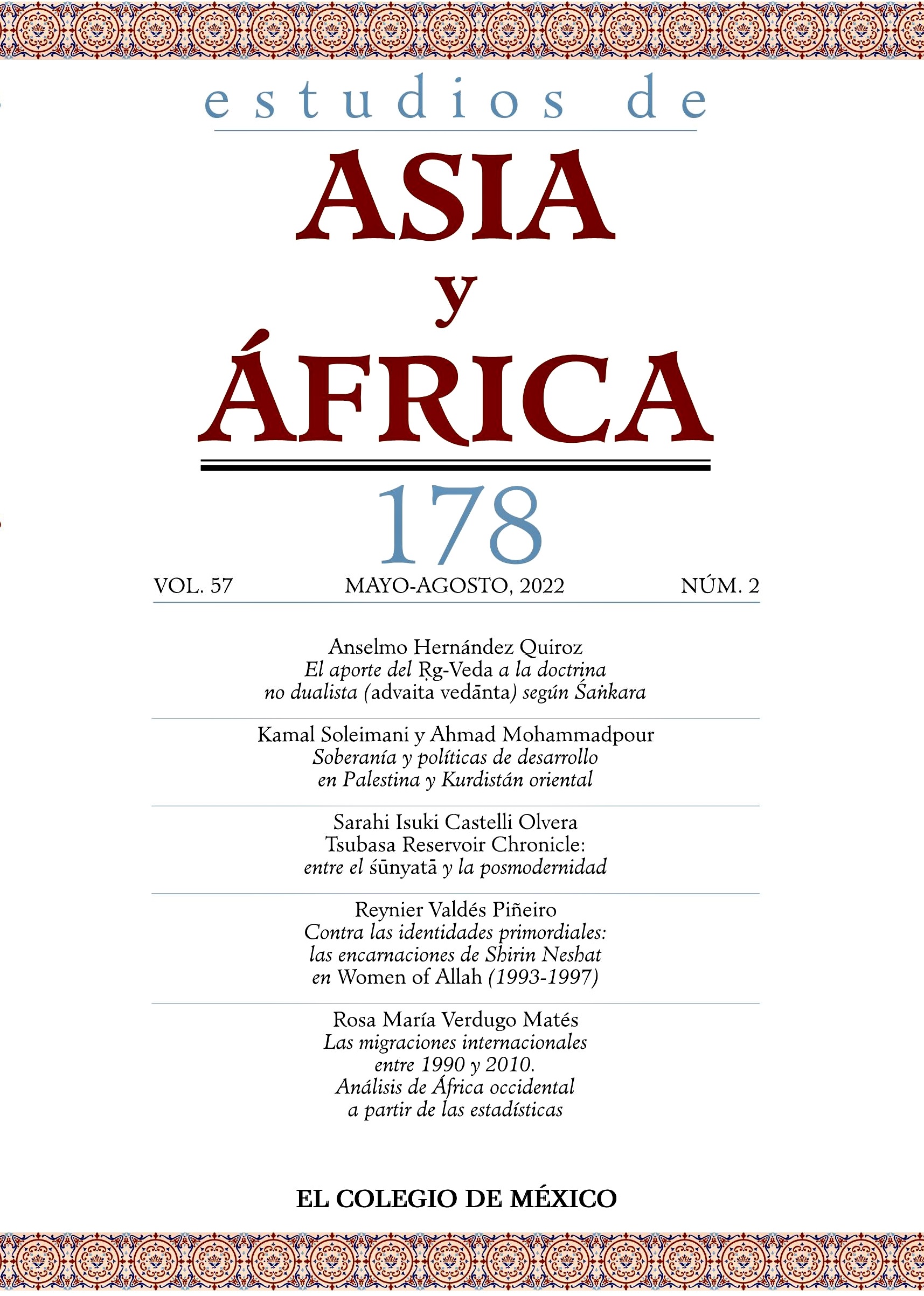Abstract
Between 1993 and 1997, the Iranian-born artist Shirin Neshat (Qazvin, 1957) produced in the United States the photographic series Women of Allah, with which she gained wide international recognition. In this series, she reflects on the affective and identity universe of Iranian Muslim women who helped defend the nation during the Iran-Iraq War (1980-1988). Neshat uses her own image to critically embody the cliché of the chador-veiled woman that has obsessed the Western hegemonic media and that conforms to the model of the “virtuous woman” as constructed by the Islamic Republic of Iran’s official discourse. The main objective of this study is to analyze how, using self-representation and Iranian poetry written by women, the artist subverts these models of representation.
References
Affleck, Ben, dir. Argo. 2012; Burbank, CA: Warner Bros. Pictures.
Barthes, Roland. 1990. La cámara lúcida. Nota sobre la fotografía. Traducido por Joaquim Sala-Sanahuja. Barcelona: Paidós.
Bhabha, Homi K. 2002. El lugar de la cultura. Traducido por César Aira. Buenos Aires: Manantial.
Chelkowski, Peter J. y Hamid Dabashi. 2000. Staging a Revolution: The Art of Persuasion in the Islamic Republic of Iran. Londres: Booth-Clibborn Editions.
Dabashi, Hamid. 2019. “The Gun and The Gaze: Shirin Neshat’s Photography”. En Contemporary Art, World Cinema, and Visual Culture: Essays by Hamid Dabashi, editado por Hamid Keshmirshekan, 139-144. Nueva York: Anthem Press.
Dadi, Iftikhar. 2008. “Shirin Neshat’s Photographs as Postcolonial Allegories”. Signs 34, núm. 1 (otoño): 125-150. https://doi.org/10.1086/588469
Danto, Arthur C. y Shirin Neshat. 2000. “Shirin Neshat”. Bomb, núm. 73 (otoño): 60-67. https://bombmagazine.org/articles/shirin-neshat/
Darznik, Jasmin. 2010. “Forough Goes West: The Legacy of Forough Farrokhzad in Iranian Diasporic Art and Literature”. Journal of Middle East Women's Studies 6, núm. 1 (invierno): 103-116. https://doi.org/10.2979/MEW.2010.6.1.103
Fanon, Frantz. 1976. Sociología de una revolución. Traducido por Víctor Flores Olea. México: Era.
Farrojzad, Forugh. 2004. Nuevo nacimiento. Traducido por Clara Janés y Sahand. Madrid: Ediciones del Oriente y del Mediterráneo.
Goodarzi Dibaj, Morteza. 2011. The Art of Painting in Post Revolution Era. Teherán: Alhoda International Cultural, Artistic & Publishing Institution.
Hall, Stuart. 2003a. Da diáspora: identidades e mediações culturais. Organizado por Liv Sovik; traducido por Adelaine La Guardia Resende et al. Belo Horizonte: UFMG.
Hall, Stuart. 2003b. “Introducción: ¿quién necesita ‘identidad’?”. En Cuestiones de identidad cultural, editado por Stuart Hall y Paul du Gay, 13-39. Buenos Aires: Amorrortu.
Hall, Stuart. 2003c. “The Spectacle of the Other”. En Representation: Cultural Representations and Signifying Practices, editado por Stuart Hall, 223-290. Londres: Sage.
Irving, Sarah. 2012. Leila Khaled: Icon of Palestinian Liberation. Londres: Pluto Press.
Jones, Amelia. 2002. “The ‘Eternal Return’: Self‐Portrait Photography as a Technology of Embodiment”. Signs 27, núm. 4 (verano): 947-978. https://doi.org/10.1086/339641
Jones, Rachel Bailey. 2011. Postcolonial Representations of Women: Critical Issues for Education, Dordrecht: Springer.
Kahf, Mohja. 1999. Western Representations of the Muslim Woman: From Termagant to Odalisque. Austin: University of Texas Press.
Khany, Minoo, Christophe Balay y Mostafa Goudarzi. 2017. “The Analysis of War Reflections in Kazem Chalipa’s Paintings According to Panofsky. Case Study: Three Works on the Theme of Mother/ Woman”. Bagh- e Nazar 14, núm. 47 (abril): 55-77.
Keddie, Nikki R. 2006. Las raíces del Irán moderno. Traducido por Joan Trejo. Barcelona: Belacqva.
MacDonald, Scott y Shirin Neshat. 2004. “Between Two Worlds: An Interview with Shirin Neshat”. Feminist Studies 30, núm. 3 (otoño): 620-659. https://doi.org/10.2307/20458988
Mayayo, Patricia. 2008. Frida Kahlo: contra el mito. Madrid: Cátedra.
Mostofi, Nilou. 2003. “Who We Are: The Perplexity of Iranian-American Identity”. The Sociological Quarterly 44, núm. 4 (otoño): 681-703. https://doi.org/10.1111/j.1533-8525.2003.tb00531.x
Neshat, Shirin. 1997. Women of Allah. Turín: Marco Noire.
Nochlin, Linda. 1989. “The Imaginary Orient”. En The Politics of Vision: Essays on Nineteenth-Century Art and Society, 33-59. Nueva York: Harper & Row.
S.Za. 2012. “Jean Gaumy, Iran”. Iconic Photos. World Press. 24 de junio de 2012. https://iconicphotos.wordpress.com/2012/06/24/jean-gaumy-iran/
Said, Edward W. 2005. Cubriendo el islam. Cómo los medios de comunicación y los expertos determinan nuestra visión del resto del mundo. Traducido por Bernardino León Gross. Barcelona: Random House Mondadori.
Said, Edward W. 2006. Orientalismo. Traducido por María Luisa Fuentes. Barcelona: Random House Mondadori.
Solomon-Godeau, Abigail. 2017. Photography after Photography: Gender, Genre, History. Editado por Sarah Parsons. Durham: Duke University Press.
Spivak, Gayatri Chakravorty. 2010. Crítica de la razón poscolonial. Hacia una historia del presente evanescente. Traducido por Marta Malo de Molina. Madrid: Akal.
Stokstad, Marilyn y Michael W. Cothren. 2014. Art History. Nueva Jersey: Pearson.
Tagg, John. 2005. El peso de la representación. Traducido por Antonio Fernández Lera. Barcelona: Gustavo Gili.
Universalmuseum Joanneum. 2018. Shirin Neshat Women of Allah Translations Übersetzungen. Graz: Universalmuseum Joanneum. Catálogo en línea de la exhibición Shirin Neshat: Frauen in Gesellschaft / Women in Society, presentada en la Neue Galerie del 18 de enero al 22 de abril de 2018. https://www.museum-joanneum.at/fileadmin//user_upload/Neue_Galerie/Ausstellung/2018/shirin-neshat/translation_neu2.pdf
Vitali, Valentina. 2004. “Corporate Art and Critical Theory: On Shirin Neshat”. Women: A Cultural Review 15, núm. 1 (junio): 1-18. https://doi.org/10.1080/0957404042000197161
Wallach, Amei. 2006. “Missed Signals: Nuance and the Reading of Immigrant Art”. American Art 20, núm. 2 (verano):126-133. https://doi.org/10.1086/507504
Young, Alisson. n.d. “Shirin Neshat, Rebellious Silence, Women of Allah series”. Khan Academi. https://www.khanacademy.org/humanities/ap-art-history/global-contemporary-apah/20th-century-apah/a/neshat-rebellious
Zabel, Igor. 2001. “Women in Black”. Art Journal 60, núm. 4 (invierno): 16-25. https://doi.org/10.2307/778194
This work is licensed under a Creative Commons Attribution-NonCommercial-NoDerivatives 4.0 International License
Copyright 2022 Estudios de Asia y África



